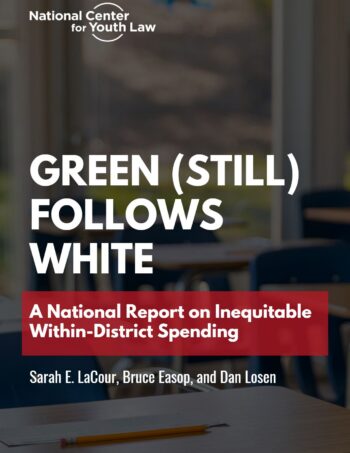Green (Still) Follows White
A National Report on Inequitable Within-District Spending

Seventy years after Brown v. Board of Education promised equal educational opportunities the disparities in school funding based on race and socioeconomic status persist. The report, “Green (Still) Follows White: A National Report on Inequitable Within-District Spending,” uncovers how these inequities continue to manifest, even within the same school districts. By exposing the distribution of resources within districts, this report highlights how systemic injustices contribute to the ongoing racial and socioeconomic isolation of students across the United States.
Understanding Resource Inequity
Resource equity in education means that every student has access to the materials, teachers, and support they need to thrive, regardless of their background. However, our report shows that resource distribution within school districts often falls short of this goal. In many cases, schools serving higher populations of marginalized students receive fewer resources than their more affluent counterparts. This inequity undermines the fundamental promise of providing every child with an equal opportunity to learn.
Key Findings
The report reveals several disturbing trends in school funding within districts, including:
- Regressive Spending Patterns: In many districts, per-pupil spending is higher for students in more privileged, predominantly white schools than for those in schools serving higher populations of marginalized students. This regressive spending pattern exacerbates existing inequities and perpetuates the cycle of disadvantage.
- Impact on Marginalized Groups: Black, Latine, Native American, and English learner students, as well as students with disabilities and those from low-income families, are disproportionately affected by inequitable resource distribution. These groups are more likely to attend schools in districts with regressive spending patterns, further hindering their educational opportunities.
- Desegregation Orders and Funding Inequities: Alarmingly, even districts under federal desegregation orders are not immune to inequitable spending practices. Our report identifies numerous districts where funding disparities persist, despite legal obligations to eliminate segregation.
Causes of Inequitable Funding
Several factors contribute to within-district funding inequities:
- Legacy of Segregation: Historical segregation and ongoing residential segregation create school districts where funding disparities reflect racial and economic divides.
- Local Fundraising and Philanthropy: Wealthier communities often raise additional funds for their schools, further widening the resource gap between affluent and marginalized schools within the same district.
- Secession and School Boundaries: The formation of new districts or the re-drawing of school boundaries can exacerbate funding inequities, as more privileged families seek to maintain advantages by isolating their schools from less affluent areas.
Recommendations
To address these inequities, advocates must push for more transparent and equitable distribution of resources within school districts. Recommendations include:
- Demand Transparency: School districts should publish accessible, detailed school-level budget documents, enabling advocates to track how funds are allocated.
- Engage in Local Policy Discussions: Advocates should participate in school board meetings and policy discussions, pressing for equitable funding models that prioritize the needs of marginalized students.
- Focus on Root Causes: Identifying and addressing the underlying causes of funding inequities, such as segregation and unequal distribution of resources, is essential for creating long-term change.
By increasing awareness and advocating for policy changes, we can work toward a more equitable education system where every child has the resources they need to succeed.